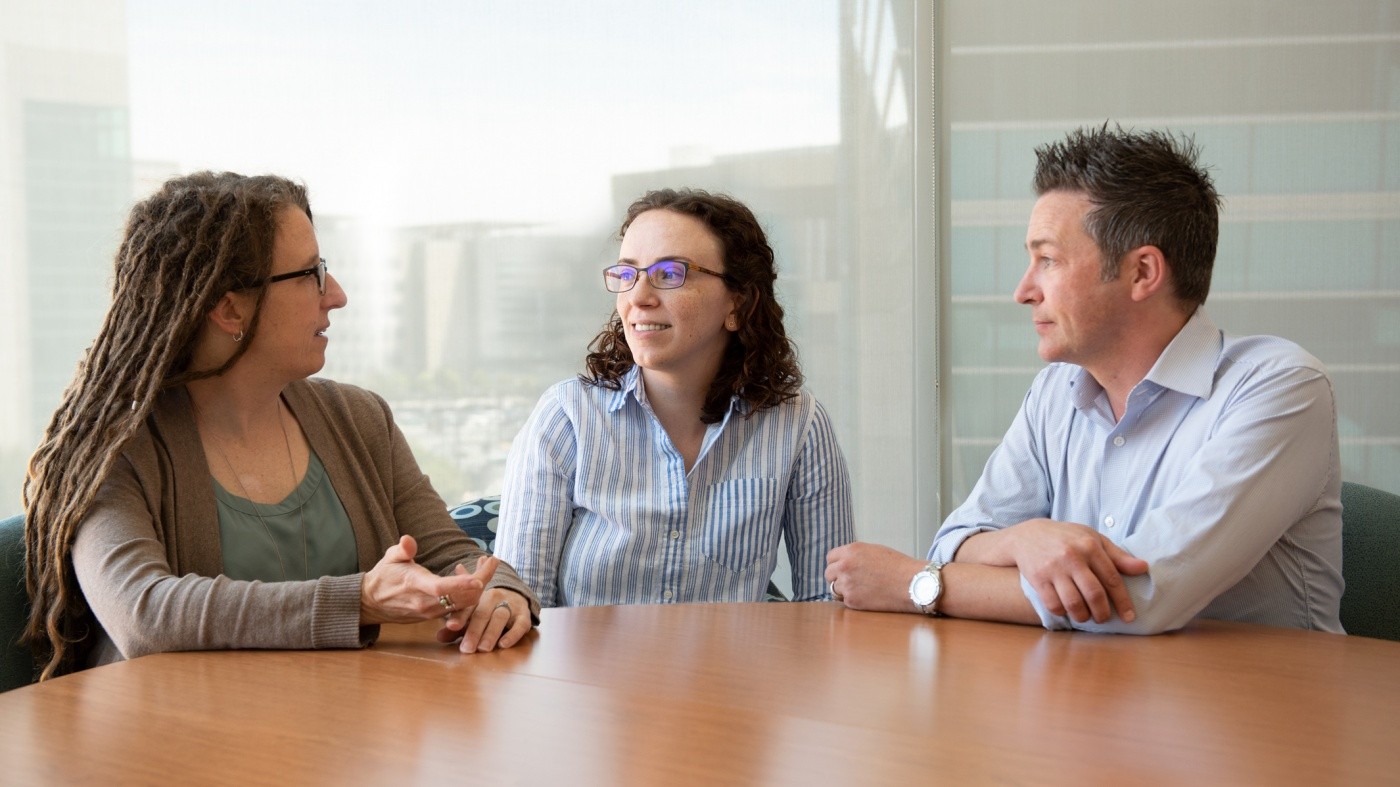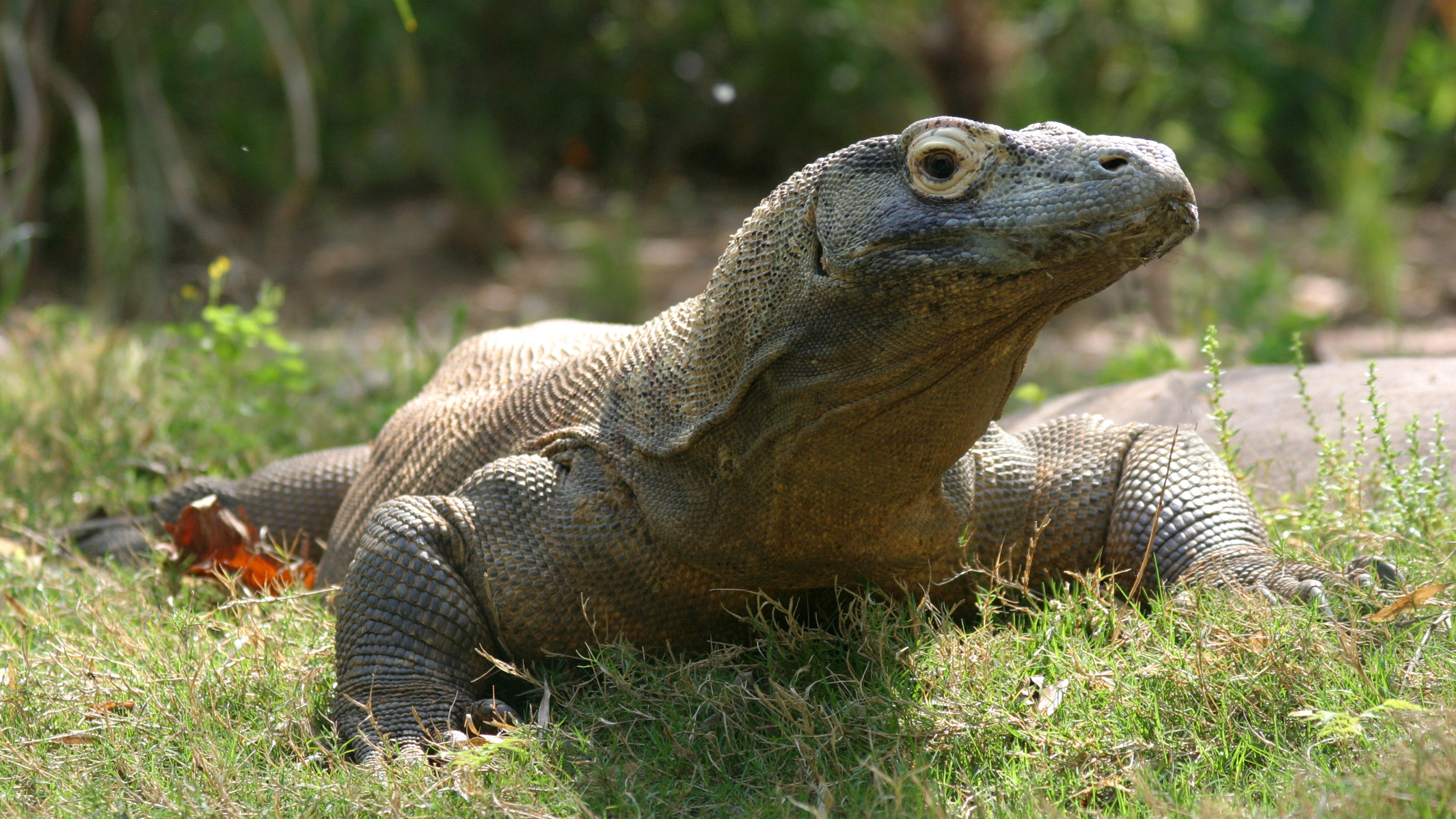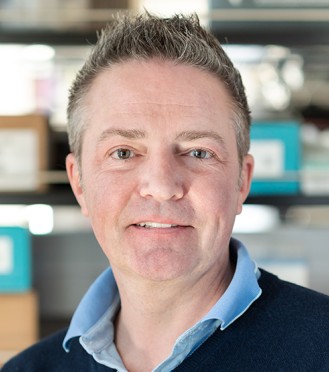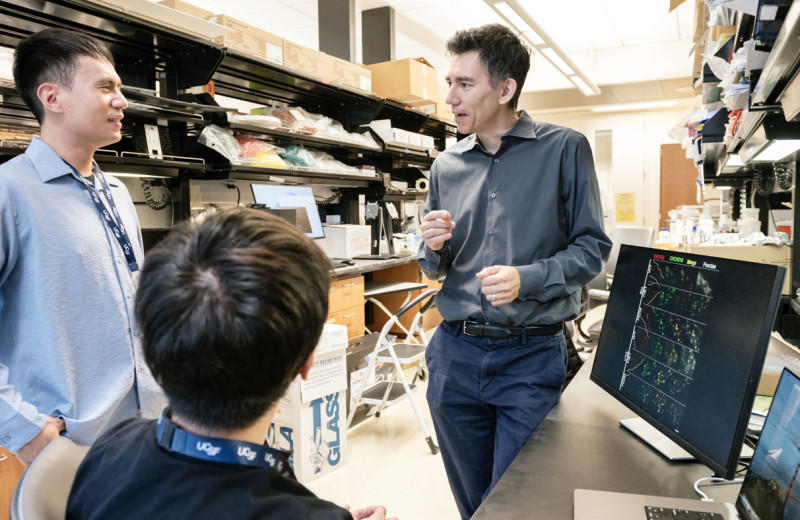Gladstone NOW: The Campaign Join Us on the Journey✕

Gladstone researchers Katherine Pollard (left), Abigail Lind (center), and Benoit Bruneau (right), in collaboration with Zoo Atlanta, are the first to sequence of the Komodo dragon genome.
The Komodo dragons are the largest lizards in the world. These predators weighing up to 200 pounds can detect their prey from up to 7.5 miles away. And although they are cold-blooded, they can ramp up their metabolism to near mammalian levels, which gives them great speed and endurance. However, scientists have understood little about how the DNA of these remarkable lizards encodes such astounding characteristics.
Now, a new study from researchers at the Gladstone Institutes, in a close collaboration with scientists at UC San Francisco (UCSF) and Zoo Atlanta, provides the first high-resolution sequence of the Komodo dragon, as well as insight into how it evolved.
“We started the project 9 years ago to look at how genomes evolve, but to do so, we needed the genome sequences first,” said Gladstone Senior Investigator Benoit Bruneau, PhD, a senior author of the study. “At the time, other groups had sequenced the turtle genome, snake and bird genomes, and the crocodile genome was in process, but the missing branch was the varanid lizards—the family to which Komodo dragons belong.”
“I went to Komodo Island years ago as a tourist, and I saw Komodo dragons in the wild there,” said Katherine Pollard, PhD, a senior investigator and the director of the Gladstone Institute of Data Science and Biotechnology, who is the other senior author of the study. “I never would have guessed then that I would one day work on their genome. We didn’t even have a human genome at that time!”
The team studied the DNA of two Komodo dragons from Zoo Atlanta named Slasher and Rinca, whose blood samples were obtained as part of their scheduled annual check-ups.

Slasher (1992-2013), Komodo dragon (Courtesy of Zoo Atlanta)
“This project was a great opportunity for us to learn more about Komodo dragons using the newest and best technologies, and then be able to contribute our findings toward the general knowledge of lizard biology,” said Joseph R. Mendelson III, PhD, a herpetologist and evolutionary vertebrate biologist, and the director of research at Zoo Atlanta.
The study, which was published in the journal Nature Ecology & Evolution and released on BioRxiv as a preprint with a data repository, provides an extremely high-quality sequence of the Komodo dragon genome, which can now be used as a reference in efforts to sequence other vertebrate genomes.
“Vertebrate genomes are big, and they contain many repetitive sequences,” explained Pollard, who is also a professor at UCSF and a Chan Zuckerberg Biohub investigator. “Most sequencing technologies only produce short stretches of sequence at a time. When those short stretches include repetitive elements, it’s impossible to know where they belong and what they connect to, making it hard to string them together.”
To get around this problem, the team took a multi-pronged approach.
“We used multiple technologies, including long-range sequencing and a physical mapping technique to do the assembly,” said Bruneau, who is also the director of the Gladstone Institute of Cardiovascular Disease and a professor in the Department of Pediatrics at UCSF. “As a result, we have a super deep, very high-quality sequence for the Komodo.”
Once the scientists had the sequence, they used computational tools to compare it to that of other reptiles and see what makes the Komodo dragon genome unique.
Specifically, they were looking for changes in the genome that helped the Komodo dragon adapt to its environment, which have undergone an evolutionary process called positive selection. A remarkable finding was that positive selection has shaped several genes involved in the function of mitochondria, the energy powerhouses of the cell that control how well heart and other muscles function.
“Our analysis showed that in Komodo dragons, many of the genes involved in how cells make and use energy had changed rapidly in ways that increase the lizard’s aerobic capacity,” said Abigail Lind, PhD, a postdoctoral researcher in Pollard’s lab and first author of the study. “These changes are likely key to the Komodo’s ability to achieve near-mammalian metabolism.”
"This was an opportunity to look at a genome and say, ‘Tell me the story of your organism.’”
Lizards are generally not known for their high aerobic capacity. In other words, they become exhausted quickly after physical exertions.
“However, we know from working with Komodo dragons that they’re capable of sustained aerobic activity, which could be swimming, running, or walking extremely long distances,” explained Mendelson, who is also an adjunct associate professor at the Georgia Institute of Technology. “Our study showed us that the secret is in these mitochondrial adaptations to increase their cardiac output. This gives us an understanding of how these animals are able to do what we had been observing.”
In addition, the researchers discovered that Komodo dragons, along with some other lizards, have an unexpectedly large number of genes that encode chemical sensors known as vomeronasal receptors. These receptors are part of a sophisticated sensory system that allows animals to detect hormones and pheromones.
This type of sensing is involved in a variety of activities, including kin recognition, mate choice, predator avoidance, and hunting. In the Komodo genome, the team found over 150 copies of one class of vomeronasal receptor genes. The team also found that many of these genes are unique to each individual lizard species, raising the possibility that the Komodo dragon’s vomeronasal receptors may function in Komodo-specific ways.
“It will be interesting to determine whether this explains Komodo dragons’ ability to detect prey over such large distances,” said Bruneau. “One of the exciting things about this project is that we didn’t know what to expect. This was an opportunity to look at a genome and say, ‘Tell me the story of your organism.’”
Next, Bruneau and his team are looking forward to using their findings to investigate how genes that control the formation of the vertebrate heart have changed over the course of evolution, as most reptiles have only a three-chambered heart, while mammals have four chambers.
The completed genome sequence also represents an invaluable resource for conservation biologists interested in tracking Komodo dragons to study their ecology, and for the many scientists across the world investigating vertebrate evolution.
“The significance of this study far exceeds Komodo dragons,” said Mendelson. “It gives us a framework to compare other sequenced animals and understand the genetic basis for how all their characteristics have evolved. This project also brings to the forefront the importance of preserving biodiversity, and the important role zoos can play in broad-scale research without being injurious to the animals in our care.”
Other authors include: Alisha K. Holloway from Gladstone; Yvonne Y.Y. Lai, Yulia Mostovoy, Angel C.Y. Mak, Walter L. Eckalbar, and Pui-Yan Kwok from UCSF; Alessio Iannucci, Marco Fondi, Valerio Orlandini, Renato Fani, and Claudio Ciofi from the University of Florence; Massimo Milan and Tomaso Patarnello from the University of Padova; Michail Rovatsos, Martina Johnson Pokorná, Marie Altmanová, and Lukáš Kratochvíl from Charles University; Ilya G. Kichigin, Alex I. Makunin, and Vladimir A. Trifonov from the Institute of Molecular and Cellular Biology of the Siberian Branch of the Russian Academy of Sciences; Elio Schijlen from Wageningen University; Petr Velenský and Ivan Rehák from Prague Zoological Garden; Tim S. Jessop from Deakin University; James W. Hicks from UC Irvine; Oliver A. Ryder from the San Diego Zoo.
The work at Gladstone was supported by the National Heart, Lung, and Blood Institute (grant HL098179), the Younger Family Foundation, and Gladstone.
For Media
Julie Langelier
Associate Director, Communications
415.734.5000
Email
About Gladstone Institutes
Gladstone Institutes is an independent, nonprofit life science research organization that uses visionary science and technology to overcome disease. Established in 1979, it is located in the epicenter of biomedical and technological innovation, in the Mission Bay neighborhood of San Francisco. Gladstone has created a research model that disrupts how science is done, funds big ideas, and attracts the brightest minds.
Featured Experts
Support Discovery Science
Your gift to Gladstone will allow our researchers to pursue high-quality science, focus on disease, and train the next generation of scientific thought leaders.
Six Gladstone Scientists Named Among World’s Most Highly Cited Researchers
Six Gladstone Scientists Named Among World’s Most Highly Cited Researchers
The featured scientists include global leaders in gene editing, data science, and immunology.
Awards News Release Corces Lab Doudna Lab Marson Lab Pollard Lab Ye LabThe Genome Editing Playbook Is Different in Neurons
The Genome Editing Playbook Is Different in Neurons
The striking findings of a new study could influence how gene therapies are designed for many genetic diseases.
News Release Research (Publication) Neurological Disease Conklin Lab Doudna Lab CRISPR/Gene EditingEvidence Builds for Disrupted Mitochondria as Cause of Parkinson’s
Evidence Builds for Disrupted Mitochondria as Cause of Parkinson’s
A new study from Gladstone Institutes strengthens the links between energy breakdown in cells and the onset of Parkinson’s, potentially illuminating new paths for treatment.
News Release Research (Publication) Parkinson’s Disease Neurological Disease Nakamura Lab





